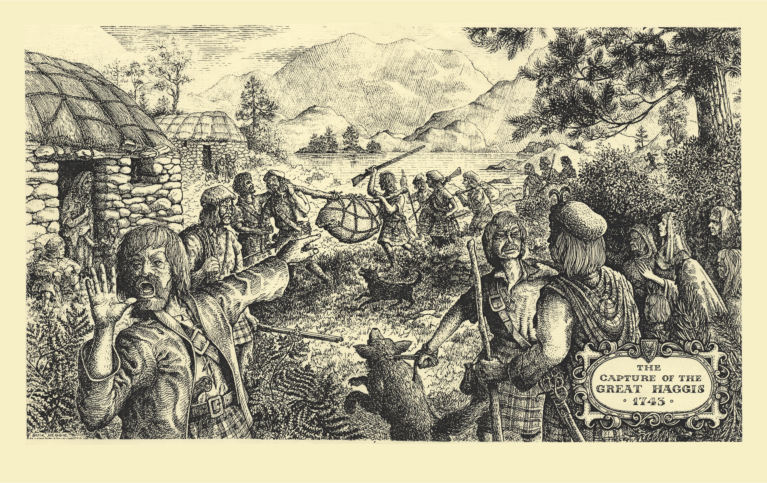Physiology and Habitat
The Wild Haggis is a small, rough-haired quadruped creature, native to the Scottish Highlands. A notable feature is that the legs on one side of the animal’s body are both significantly longer than those on the other, this being a local long-term evolutionary adaptation to living on the steep sides of Scottish mountains.
Haggis* thus adapted can only travel with any ease or speed in one direction – clock-wise (Haggis Scottii dexterous), or anti-clockwise (Haggis Scotti sinistrous), depending on whether the legs are longer on the left or the right side of the animal. If the shorter legs do not remain on the up-slope side of the hapless beastie it is in severe danger of falling over sideways and rolling to the bottom of the hillside.
The Great Haggis – The Capture of The Great Haggis, 1743

Haggis History
The Hebridean Haggis is thought to be the original native species from which all other haggis are descended. This breed of haggis was much smaller and more hardy than the mainland varieties and formed part of the staple diet of the ancient Scots.
It is believed that the present wild haggis population is descended from the feral haggis, which in turn were the descendants of the domesticated Hebridean haggis, abandoned when the native Scots crofters and their families were forced to leave the land at the time of the Highland Clearances (Scottish Gaelic: Fuadach nan Gàidheal, the expulsion of the Gael), the forced displacements of the population of the Scottish Highlands during the 18th and 19th centuries.
Like the crofters themselves, the haggis faced extinction through competition with the large numbers of sheep which were introduced as part of a process of agricultural change, considered to be necessary ‘improvements’ by the land owners. Owing to their inability to move on other terrain, plus their need for a constant supply of local heather and peaty burns – haggis have an acute sensitivity to water pH balance – none of the live pet haggis which the crofters attempted to take with them survived for more than a few days away from their native mountain sides.
A large number of wild haggis still roam the moors and machair of the Western Isles and, despite the Isles of Lewis and Harris having a strict Sabbatarian tradition, the Hebridean Haggis Hunt is one of the few events that takes place on a Sunday across all of the islands – including Lewis and Harris.
The Lewis Haggis is different from the Haggis on the mainland: unlike its mainland relative all its legs are of the same length. Capturing of wild haggis on Lewis is a traditional community event. At dusk, the young men of the villages go out on to the moors to form a wide semi-circle while the elders cover peat creels with heather and turf, just leaving the opening visible. The young men, acting as ‘beaters’, drive the haggis towards the traps.
On perceiving the elders, the haggis panic, seek shelter and mistaking the creels for burrows the haggis are caught, quickly dispatched and passed to the women-folk for skinning. The haggis are then soaked in brine for a couple of days to become tender and ready to cook. (According to an authoritative source, a resident of Lewis, traditionally the haggis skin would be used as a sporran, but with the decline in kilt wearing over the years the skins are now often discarded.)
Haggis sub-species
Regional, and indeed very specifically local sub-species of haggis exist, identifiable to the true haggis expert because the actual difference in the length of the legs is dependent on the steepness of the slopes within their habitat. Haggis are thus adapted to the angle of slope in a geographically very small area, resulting in the haggis being ‘clannish’, fiercely territorial and pure-bred. It is virtually impossible for courtship and mating to occur between Haggis Scotti dexterous and Haggis Scotti sinistrous individuals in the wild, since in order for the male of one variety to mate with a female of the other, he must turn to face in the same direction as his intended mate, causing him to lose his balance before he can mount her.
Haggis Hunting
During the Haggis Season Ghillies who are familiar with the local terrain take advantage of the delicate issues facing the male haggis on finding a mate by releasing Haggis Scottii dexterous females into known Haggis Scotii sinistrous territory, (or vice versa) thus attracting the attention of local males whose brief, hazardous and ultimately pathetic pursuit of the objects of their amorous desire is inevitably fatal, as they are an easy target for the Haggis Hunters.
The Golden Haggis is much more common in the Western Isles (especially on the machair) than on the mainland and commands a premium price. All wild haggis is therefore considered to be a great delicacy, to be prepared and presented with care and ceremony and eaten on special occasions.
(* Note that the plural of haggis is haggis)




